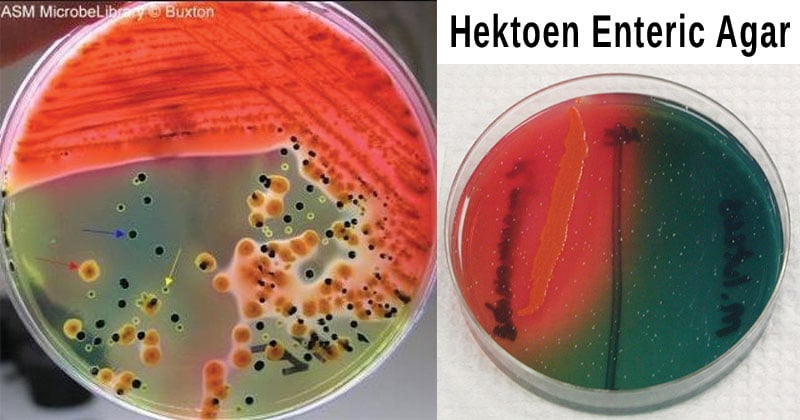- Hektoen Enteric Agar is a selective and differential medium designed to isolate and differentiate members of the species Salmonella and Shigella from other Enterobacteriaceae.
- The medium was introduced in 1968 by Sylvia King and William I. Metzger. They formulated HE Agar medium while working at the Hektoen Institute in Chicago, to increase the recovery Salmonella and Shigella from clinical specimens.

Interesting Science Videos
Composition of Hektoen Enteric Agar
| Ingredients | Gms/liter |
| Protease peptone | 12.00 |
| Yeast extract | 3.000 |
| Lactose | 12.00 |
| Sucrose | 2.000 |
| Salicin | 9.000 |
| Bile Salts mixture | 9.000 |
| Sodium chloride | 5.000 |
| Sodium thiosulfate | 5.000 |
| Ferric ammonium citrate | 1.500 |
| Acid fuchsin | 0.100 |
| Bromothymol blue | 0.065 |
| Agar | 14.00 |
Final pH (at 25°C): 7.5±0.2
Principle of Hektoen Enteric Agar
- Hektoen enteric (HE) agar is a medium that relies on the use of bile salts for selective inhibition and two indicator systems:
- bromothymol blue and acid fuchsin as indicators of carbohydrate dissimilation and
- ferric iron as an indicator of the formation of hydrogen sulfide from thiosulfate.
- HE agar allows a good growth of Shigella because the inhibition of these organisms by bile salts is reduced by the addition of relatively large amounts of peptone and carbohydrates.
- The medium provides good colonial differentiation and inhibits some coliforms and other nonlactose-fermenting bacteria, thereby facilitating the identification of Salmonella and Shigella from food products.
- HE agar is composed of proteose peptone, yeast extract, sodium chloride, lactose, sucrose, salicin, bromothymol blue, acid fuchsin, sodium thiosulfate, iron (III) ammonium citrate, bile salts, agar, and distilled or deionized water.
- On HE agar, Salmonella produces transparent green or blue-green colonies with or without black centers and appears as almost completely black colonies.
- Shigella produces green, transparent colonies. As other organisms forms colonies similar to Salmonella and Shigella, biochemical and serological confirmatory tests are necessary.
- Lactose, sucrose, or salicin fermenting gram-negative bacteria produces salmon-colored colonies.
Preparation and Method of Use of Hektoen Enteric Agar
- Suspend 72.66 grams in 1000 ml purified/ distilled water.
- Heat to boiling to dissolve the medium completely.
Note: DO NOT AUTOCLAVE.
- Cool to 45-50°C.
- Mix well and pour into sterile Petri plates.
- Inoculate the medium with fresh faeces suspended in Ringers solution or inoculate directly with rectal swabs.
- Spread the inoculum to obtain well-separated colonies.
- Incubate for 18-24 hours at 37°C.
- Further incubation will improve differentiation between Salmonella and Shigella.
Result Interpretation on Hektoen Enteric Agar
- Rapid lactose fermenters (such as E. coli) are moderately inhibited and produce bright-orange to salmon pink colonies.
- Salmonella colonies are blue-green typically with black centers from hydrogen sulfide gas.
- Shigella appear greener than Salmonella, with the color fading to the periphery of the colony.
- Proteus strains are somewhat inhibited; colonies that develop are small transparent and more glistening or watery in appearance than species of Salmonella or Shigella.
| Organisms | Growth |
| Salmonella Typhimurium | Blue-green with or without black centers |
| Salmonella Abony | Blue-green with or without black centers |
| Salmonella Enteritidis | Blue-green with or without black centers |
| Salmonella Typhi | Blue-green with or without black centers |
| Escherichia coli | Orange (may have bile precipitate) |
| Shigella flexneri | Greenish blue |
| Shigella sonnei | Growth good to excellent; colonies light green |
| Proteus | Variable, blue-green to blue or salmon, most strains with black center or completely black |
| Enterobacter/Klebsiella | Large, yellow to salmon color |
Uses of Hektoen Enteric Agar
- Hektoen Enteric Agar Medium is recommended for differential and selective isolation of Salmonella and Shigella species from enteric pathological specimens in accordance to United States Pharmacopoeia.
- This medium is recommended by United States Pharmacopoeia, 2009 for testing the presence of Salmonella in dietary supplements.
- This medium is recommended in the testing of Salmonella in food sample by various standards.
- HE agar is currently used as both a direct and indirect plating medium for fecal specimens to enhance the recovery of species of Salmonella and Shigella from heavy numbers of mixed normal fecal flora.
- It is used as a plating medium to recover gastrointestinal pathogens, such as Salmonella and Shigella, from food, water, and fecal samples suspected of containing these organisms.
Limitations of Hektoen Enteric Agar
- A single medium is only rarely able to recover all pathogens contained in a specimen. Therefore, additional media for the isolation of Salmonella and/or Shigella and possibly for other enteric pathogens must be inoculated with the specimen.
- Proteus mirabilis colonies may resemble Salmonella on this medium.
- Certain Shigella strains may need a 42 to 48 h incubation.
- Although certain diagnostic tests may be performed directly on this medium, biochemical and, if indicated, immunological testing using pure cultures is necessary for complete identification.
- Colonies suspected of being Salmonella or Shigella must be confirmed and identified biochemically and serologically.
References
- http://www.austincc.edu/microbugz/hektoen_enteric_agar.php
- https://microbeonline.com/hektoen-enteric-agar-composition-principle-uses/
- http://www.himedialabs.com/TD/MU467.pdf
- https://www.sciencedirect.com/science/article/pii/S0079635203800565
- https://www.bd.com/resource.aspx?IDX=8970
- http://www.oxoid.com/UK/blue/prod_detail/prod_detail.asp?pr=CM0419&org=124&c=UK&lang=EN
